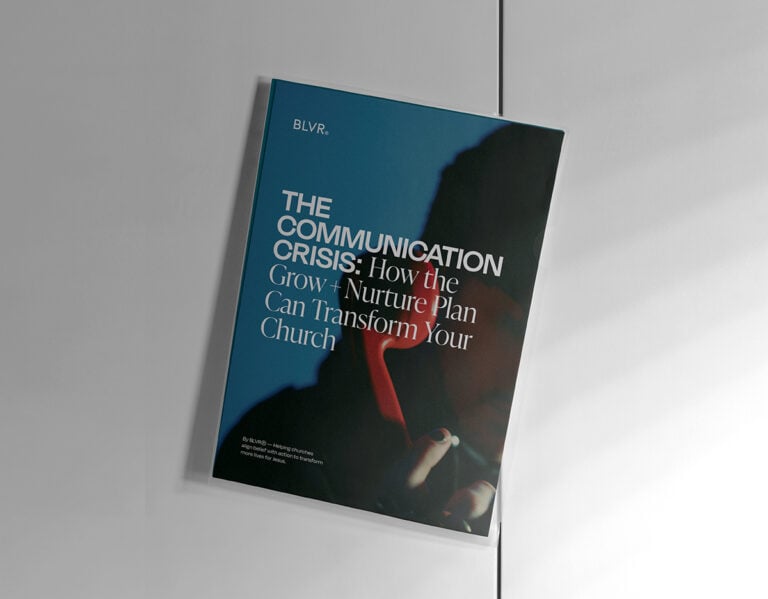
Church Branding / BY Scott Hancock
If Your Church Can’t Be Explained in One Sentence, You Have a Problem
Published On 10.23.2024
Article
If someone asked you to explain what your church is all about in just one sentence, could you do it? Would that explanation be clear and compelling enough to make someone want to learn more, attend a service, or get involved?
Most churches would say their mission is to “believe in Jesus and share the Gospel.” But here’s the reality: Every Christian church shares that belief. What sets your church apart isn’t that you believe in Jesus, but how your church uniquely lives out that belief. This is your church’s core belief—the specific conviction that drives everything you do.
And if you can’t explain your church’s core belief in one sentence, you have a problem.
The Identity Crisis Hiding in Plain Sight
Theological beliefs—like believing in Jesus and the Gospel—are the foundation of every church. But many churches mistake their theology for their identity, and that’s where the problem starts. Without a clear, core belief that defines how you live out your faith, your church’s message can get lost in the noise.
Here’s the hard truth: If your church doesn’t unlock or articulate a unique core belief, it risks becoming just another church in the crowd.
You might have good intentions, but without a clear identity that drives your mission, your congregation may not feel deeply connected, your community may not notice you, and your outreach may not make the impact you hoped for. Without clarity, your church becomes just another place to gather rather than a movement people want to be part of.
The Difference Between Theology and Core Belief
Let’s make one thing clear: Every Christian church believes in Jesus. But that’s not your church’s core belief—that’s your theological foundation, something all churches share. Your core belief is the unique way your church expresses that foundation. It’s the specific conviction that drives every action, program, and decision.
Think of it like this:
- Theological belief is the foundation—every church is built on Jesus and the Gospel.
- Core belief is the architecture—it gives your church its unique shape, character, and mission.
Your core belief is what makes your church different from others. It’s what defines how you live out your theology in a way that’s specific to your community and your calling.
For example, one church might be driven by a core belief that focuses on serving the homeless. Another might focus on building strong family relationships. Another might prioritize discipleship and deep spiritual growth. Each of these churches believes in Jesus, but they live out that belief in different, powerful ways.
So, what’s your church’s unique core belief?
The Solution: Clarify and Communicate Your Church’s Core Belief
The first step to overcoming this identity crisis is discovering and articulating your core belief. This isn’t just a mission statement or a set of values—it’s the driving force behind everything your church does. It’s the belief that gives your church a specific, unique identity.
When your core belief is clear, your congregation knows exactly who you are, what you stand for, and why it matters. And that clarity creates connection, both inside and outside your church.
Three Steps to Clarify Your Church’s Core Belief
Step 1: Identify Your Core Belief
Your core belief is what makes your church unique. It’s more than just “sharing the Gospel”—it’s how you live out that calling in a way that’s distinct to your church.
Ask yourself:
- What does our church believe above all else?
- What is the specific mission that drives us?
- What unique calling has God placed on our congregation?
Maybe your church is focused on reaching the unchurched in your city. Or perhaps you’re deeply committed to nurturing young families. Whatever it is, your core belief should reflect the heart of your church’s mission.
Action: Gather your leadership team and define your core belief. It should be specific, clear, and distinct. Once you’ve identified it, you can build everything else around that belief.
Step 2: Communicate Your Core Belief Everywhere
Your core belief needs to be reflected everywhere—from your sermons to your social media posts, from your community outreach to your website. It’s not enough to have a mission statement; your belief needs to be woven into the fabric of your church’s identity.
If your church’s core belief is focused on community outreach, every part of your church’s message should reflect that. If your core belief is about discipleship, then every sermon and ministry should emphasize growing in faith.
Action: Review all your church’s communications. Are your sermons, social media, website, and programs aligned with your core belief? If not, it’s time to adjust your messaging so that everything points back to your unique mission.
Step 3: Align Your Actions with Your Core Belief
Your core belief isn’t just something you say—it’s something you live. This is where many churches fall into the Say-Do Gap®—where your words don’t match your actions. When that happens, trust erodes, and people stop engaging.
If your church’s core belief is focused on outreach, but you aren’t actually mobilizing your congregation to serve, there’s a disconnect. Or if your belief centers on community, but your events don’t foster real connection, people will notice the gap.
Action: Evaluate your church’s programs and ministries. Do they reflect the core belief you’ve defined? If there’s a gap between what you say and what you do, it’s time to realign your actions with your belief.
Why It Matters: What’s at Stake Without Clarity?
If your church can’t clearly articulate and live out its core belief, your impact will be limited. People might attend, but they won’t feel connected. They’ll listen, but they won’t be moved to action. Over time, a lack of clarity leads to a lack of commitment—people don’t stay where they don’t feel deeply connected.
And without clarity, your outreach efforts will feel hollow. Your community won’t engage with a church whose mission is unclear or inconsistent.
The Payoff: What Happens When You Clarify Your Core Belief
Now imagine this: your congregation and community know exactly who your church is, what you stand for, and why it matters. Your members are energized because they feel part of a movement that’s making a difference. New visitors walk in and immediately connect with your mission because it’s clear, compelling, and powerful.
When your core belief is clear and lived out, your church becomes a place where people don’t just attend—they belong, participate, and share your message with others. You’re no longer just another church in the community—you’re a beacon of hope, purpose, and transformation.
YOUR NEW COMMS PLAN
Learn how your church can apply an approach that businesses have used to successfully acquire new customers and retain existing customers. Use the power of audience segmentation to deliver personalized messages that are relevant to each person within you external and internal church community.

About the Author

Scott Hancock
Partner / CEO
Scott Hancock is a thought leader in belief-driven branding and an expert in closing the Say-Do Gap®—the critical divide between what brands say and what they actually do. As CEO of BLVR®, Scott has pioneered a belief-led approach that helps organizations transform their core conviction into bold actions that inspire trust, loyalty, and market leadership.
With a reputation for pushing brands to go beyond surface-level promises, Scott’s work has been recognized by AdWeek, Forbes, and Fast Company for its fearless creativity and impactful results. His leadership has empowered BLVR® to become a trusted partner for purpose-driven brands seeking to align their actions with their core belief and create lasting change.
© BLVR
SD / CA




